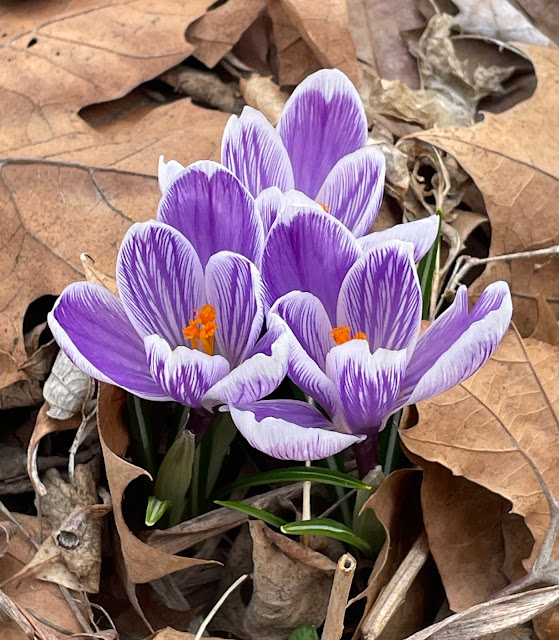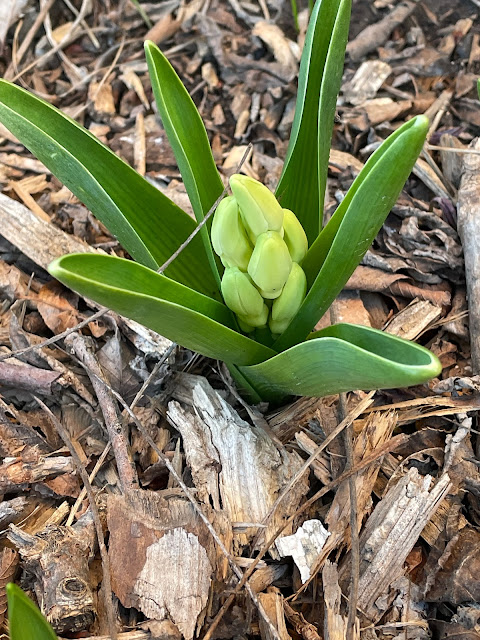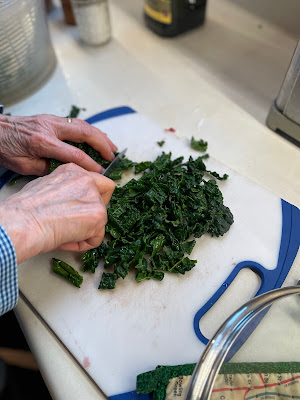Spring arrives this week. It has actually been here for weeks.
The early daffodils, the real heralds of spring, are popping open lots of places. Friday, on our morning walk, we even saw a tulip over on Court Street. There was forsythia blooming.
Every thing in early spring is short. It is all happening close to the ground.
What I love to do is stoop down and just spend time looking to see what is going on, in that one small area. There may be some blooming bulbs, like crocuses or snowdrops. Some of those at this point may be finished. But there is always so much more. There are the seedlings that can be very small. There are seedlings of aconite and scilla (squill) everywhere. There are so many of them that they give you an appreciation for very large numbers.
Then in that small area you find the new plants, just emerging. The bluebells are coming, both the ones from Virginia and the ones from England. The Virginia bluebells will come to dominate parts of the garden in the next month. They will be one of the first plants to get to be taller than maybe 6 inches.
There are so many other plants that may be there. Lupines and their seedlings. Corydalis both from established plants and the ones 1-2 feet away that have grown from seed. Tree Peony seedlings. Pulmonaria. Celandine poppies. The lesser spring blubs, including the chionodixia, both pink and blue. The pushkinia.
There are many plants I forget in that first list. These next ones are all leaves at this point. But that is how most plants begin. There are allium. The first tulips are up and waiting to get some deer spray. Oriental Poppies. Shirley poppies. Epimedium. There is a little iris called bucharica. I just planted more of this unusual variety last fall.
Then you watch for the plants to come. Where is the bloodroot or the first small trillium? I looked and sure enough, they are there.
This time when everything is sort, is something that is unique to spring. By summer those small squares will be filled with hosta or daylilies. As I think about it those plants will be bigger and taller. It would make no sense to stoop to look at them.
Last Week in the contest the easy winner was the dogwood.
Here was the full vote.
This Week is the finals.
We began this trip Thanksgiving weekend. There have been 16 weeks of the contest. We have come down to these three pictures. Two of them, the crocuses and the dogwood, tied in Week 13. Change one vote and only one would have advance. They both had easy wins in the playoffs. Can the Frosty Kale pull out a victory and become the first picture from December to win the contest? Actually there has never been winner from any month later than September.
I have pictures of 17 winners. Which month would you think would be most represented? If you guessed May you would be correct. There were 5, followed by April with 4. The latest in the season was September 17.
So here are the three pictures you selected.
#1 The dogwood
May 3, 2023
There you have it. These three pictures are the finalists for the winter contest for 2023-24.
Rught Now
It is time for the later blooming crocuses.
You can never have enough. That is related to the idea that "I should get some more."
Most late crocuses are larger. This variety was/is an exception.
Julia's Recipe
One pot pasta
This is a NYT recipe, which apparently was a big deal sometime in the past but I missed it the first time around. It's vegetarian (can be vegan); fast and tasty. We had it as a main course, but it could certainly be a side with a piece of fish or chicken. Philip forgot to take a picture of the ingredients, but that's okay. There aren't that many ingredients, and I will list them below.
The ingredients:
1/2 lb. spaghetti;
1 pint cherry tomatoes;
1 bunch lacinato kale;
1 lemon (for zest);
1/4 cup olive oil;
1 teaspoon salt;
some pepper; and
some parmesan cheese.
I pulled out a big skillet, one that was big enough to hold the uncooked spaghetti without breaking it. I put the spaghetti in the skillet. Then I cut all of the cherry tomatoes in half and added them. I put the tea kettle on because I was going to need 2-1/2 (or so) cups of boiling water.
Next, I zested the lemon on top of the tomatoes, added the olive oil and the teaspoon of salt and some grinds of pepper.
Then I poured in the boiling water. I started with 2 cups. I brought the contents of the skillet to a boil (which did not take long) and then simmered the mixture for about 6 minutes. I stirred the contents a bit as the spaghetti softened. It looked dry so I added a little more water. Maybe 1/2 cup extra in all. The water in the tea kettle was still plenty hot.
Here it is as the spaghetti was loosening up.
While that was going on, I removed the stems from the kale, the most annoying part of the whole process. But I had young-ish lacinato kale which I knew would be pretty tender, so annoying was in a good cause.
After the kale was de-stemmed, I washed it...
and sliced across the leaves to get kale strips. I was not precise in width - probably about 1/2" wide.
When the 6 minutes had passed and the spaghetti looked mostly done, I added the kale in handfuls. There was a lot of kale, but kale (like all such greens) wilts pretty quickly and the volume is reduced.
The idea is that the pasta water, with whatever liquid was generated by the tomatoes and kale and by the oil, would turn into a sauce. And it did.
After the kale had wilted, I turned everything out onto a nice platter and sprinkled it with parmesan, which was also on the table for extra sprinkling.
Odds and Ends
I have mentioned garden yardsticks or mile posts.
Forsythia- While I do not grow it, we have seen it in the neighborhood this past week.
Star magnolia- In 2012, that very warm spring, the Start magnolia bloomed on March 18. In 2024 it has started to bloom. Since it is not in full bloom, I would say that 2012 was a few days earlier than this year.
I should mention that it is cooling off at the moment. We had 3 days in the low 70's this week, along with some nice rain on Thursday. What was important for accelerating plant development was the fact that the lows this past week stayed above freezing.
This coming week with give us temperatures at night in the 20's. tonight is predicted to get to 20. That is cold enough to make you worry a little. But worrying will not make much difference.
Daylight savings time is here. Having awakened this morning (Sunday) at 4:15 I think my biological clock has adjusted. I do miss that light at 6:30 in the morning. I was able to do some gardening before work.
Normals temperatures for this time of year are 50 for highs, 30 for low.
There will be some new plants in the garden this spring. This is iris bucharica. We had it for years in the front yard, by the sidewalk. It slowly disappeared. We got some more this past fall and it is coming up.




























2 comments:
Congratulations on another great contest. I voted for the kale, but still pine for the first Shirley semi-finalist.
Julia, this the first time I’ve ever cooked an exact recipe before reading your commentary. I made a lot of pastas with cherry tomatoes last year and plan to do it again. It isn’t necessary to halve the tomatoes—they are quite efficient in self-destructing.
I asked a chef friend why you have to boil pasta in such high quantities of water. “Don’t,” she replied. She claims that as long as the pasta is totally covered, you’re fine. That tip has saved me a lot of time and water.
Happy Spring!
Another nice cooking video--not as sizzling as last week, but good nonetheless. Looks mighty tasty!
I have been a staunch supporter of the dogwood all this season, and my support has not weakened. But things are not looking good--the crocuses may take the cake. Admittedly, they're gorgeous too.
By this stage in the contest, they're all winners, right?
Stay well.
Post a Comment